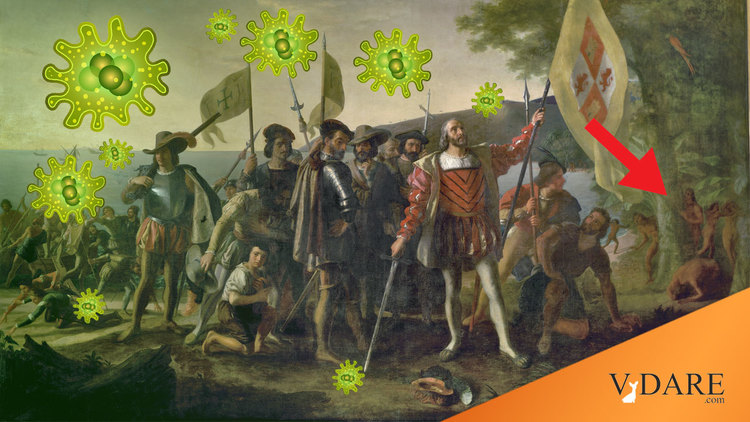 But there was some evidence that this sad assumption wasn’t completely true. For example, in the 1997 biopic of the Mexican-American singer Selena, Puerto Rican-American Jennifer Lopez was credibly cast as the mestizo star.
But there was some evidence that this sad assumption wasn’t completely true. For example, in the 1997 biopic of the Mexican-American singer Selena, Puerto Rican-American Jennifer Lopez was credibly cast as the mestizo star.

By Steve Sailer
12/23/2020
Up through 2000 or so, it was assumed by scientists that the entire Amerindian population of most Caribbean Islands, such as Hispaniola (modern Haiti and Dominican Republic), but not of the mainland of the New World, had gone extinct after Columbus introduced Old World diseases to the New World. Modern Caribbean peoples were assumed to be wholly a mixture of imported blacks and whites.
 But there was some evidence that this sad assumption wasn’t completely true. For example, in the 1997 biopic of the Mexican-American singer Selena, Puerto Rican-American Jennifer Lopez was credibly cast as the mestizo star.
But there was some evidence that this sad assumption wasn’t completely true. For example, in the 1997 biopic of the Mexican-American singer Selena, Puerto Rican-American Jennifer Lopez was credibly cast as the mestizo star.
As DNA analysis improved in this century, however, it was discovered that single or low double digit percentages of Amerindian ancestry survived among Puerto Ricans and the like.
From The New York Times opinion section:
Ancient DNA Is Changing How We Think About the Caribbean
New research delivers surprising findings about Indigenous people in the region before contact with Europeans.
By David Reich and Orlando Patterson
Dr. Reich is a geneticist at Harvard who specializes in the study of ancient DNA. Dr. Patterson is a sociologist at Harvard with expertise in the Caribbean.
Patterson is a Jamaican-American mulatto, whose Jamaicanness presumably is assumed to empower him to comment on the fate of the indigenous populations of Jamaica, despite not showing his DNA test results proving he is descended from some Amerindians. Anyway, it’s a good strategy for Reich to recruit senior Harvard professors like Patterson of more or less the appropriate ancestry to co-write his mainstream essays with him.
Dec. 23, 2020, 11:00 a.m. ET
In 1492, Christopher Columbus touched land for the first time in the Americas, reaching the Bahamas, Hispaniola (present-day Dominican Republic and Haiti) and eastern Cuba. After he returned to Spain he reported that he had encountered islands rich in gold. A few years later his brother Bartholomew, who also traveled to the Americas, reported that Hispaniola had a large population whose labor and land could be put to the advantage of the Spanish crown. He estimated the population at 1.1 million people.
The current population of Hispaniola is around 22 million, plus its emigrants.
Was this figure accurate? It soon was a matter of dispute. Bartolomé de las Casas, a Spanish monk and colonist who became the first chronicler of the human disaster that unfolded in the Americas after the arrival of Europeans, estimated a far larger number: three million to four million.
Bishop De las Casas was perhaps history’s first human rights activist for another race. He spent decades championing the indigenous people of the New World, arguing their case in front of the King of Spain and winning some reforms.
The population size of “pre-contact” Hispaniola would continue to be a contested issue until the present day, not least because of its profound emotional and moral resonance in light of the destruction of that world. Modern scholars have generally estimated the population at 250,000 to a million people.
Some of the arguments for large population numbers in the pre-contact Americas have been motivated by an attempt to counter a myth, perpetuated by apologists for colonialism like the philosopher John Locke, that the Americas were a vast “vacuum domicilium,” or empty dwelling, populated by a handful of Indigenous groups whose displacement could be readily justified. In a similar vein, some of the arguments for large population sizes have been motivated by a desire to underscore how disastrous the arrival of Europeans was for Indigenous people.
By any measure, the arrival of Europeans was catastrophic for Indigenous Americans.
This op-ed doesn’t mention that the primary reason for the catastrophe was not the evil evilness of Europeans per se, but the unwitting spread of novel diseases, such as smallpox, hundred of years before the creation of Germ Theory, even though that would be timely. But making it sound like a proto-Holocaust, rather than a huge accident, is also timely.
This is true whether the numbers of people were in the hundreds of thousands or millions — or for that matter, the tens of thousands. It is questionable to pin our judgments of human atrocities to a specific number. To learn from the past, it is crucial to be willing to accept new and compelling data when they become available.
In the case of the pre-contact population of Hispaniola, such data have arrived. By analyzing the DNA of ancient Indigenous Caribbean people, a study published in Nature on Wednesday by one of us (Professor Reich) makes clear that the population of Hispaniola was no more than a few tens of thousands of people. Almost all prior estimates have been at least tenfold too large.
I have a theory about the population densities of New World regions in 1491 based on tourist attractions: Mexico and Guatemala have a lot of pre-Columbian tourist attractions, as does Peru. Presumably, a whole lot of people lived in those parts in 1491 if they had surplus labor to build big stuff. North America less so (mounds in the Mississippi watershed mostly along with some apartment buildings in the Southwest). And I’ve never heard of any pre-Columbian ruins on Caribbean islands.
So, I’m not too surprised.
One question is why Amerindians didn’t fill up Hispaniola they way they filled up, say, the Valley of Mexico? Were the food resources insufficient? Did corn (maize) not get there? Did they kill each other in large numbers?
This research involved sequencing genetic material taken from skeletal remains. Together with another study of ancient Caribbean DNA published recently by a different lab, scientists now have data concerning the entire genomes of more than 260 people of the ancient Caribbean. (This work was done in collaboration with Caribbean scholars, with permission from Caribbean governments and institutions and in consultation with Caribbean people of Indigenous descent.)
We have better DNA studies of Caribbean and Canadian Indians than of American Indians because federal law gives American Indian tribes all sorts of weapons to block scientific research into their origins.
In recent years, researchers studying ancient DNA have accumulated more than 5,000 ancient human genomes (up from none a decade ago), making it possible to use this methodology to ask and answer questions about how past people related to one another and to people living today. The Caribbean is now the first place in the Americas where we have this kind of high-resolution data set for understanding the past, previously available only in Western Eurasia.
The finding about the pre-contact population size in Hispaniola was made possible by a new scientific advance: We are now able to detect “DNA cousins” in ancient genomes — taking two people and determining whether they share large segments of DNA inherited from a recent ancestor. This is similar to what personal ancestry companies like 23andMe and Ancestry do with living people. …
The rate of close relationships that the Reich team found is what would be expected for about 3,000 people — at most 8,000 people — in their childbearing years in Hispaniola. The true numbers of people could have been threefold to tenfold larger because at any given time only a fraction of a population is in its childbearing years. Still, we can confidently conclude that the pre-contact population size of Hispaniola was no more than a few tens of thousands of people.
… Whatever the starting population, what happened to Indigenous Americans after Europeans arrived amounted to genocide: the systematic obliteration not just of individuals but also of their culture and community — what the philosopher Claudia Card called the “social death” at “the center of genocide.”
The importation of black slaves, like Professor Paterson’s ancestors, likely overwhelmed the culture of Amerindians who happened to survive. In contrast, in upper altitude Mexico and Peru, where sub-Saharans’ genetic and personal advantages against tropical diseases didn’t give them a survival advantage, lots of indigenous communities survived. Blacks probably brought both tropical diseases and simply overwhelmed surviving indigenous communities by sheer numbers.
… Another surprising finding, for instance, is that the genetic legacy of pre-contact Caribbean people did not disappear: They contributed an estimated 14 percent of the DNA of living people from Puerto Rico, 6 percent of that in the Dominican Republic and 4 percent of that in Cuba.
 Thus, Jennifer Lopez as Selena.
Thus, Jennifer Lopez as Selena.
Would she be allowed to play Selena in 2020 out of pan-Hispanic racialist ideology?
Hard to say.
In the current Netflix series “Selena: The Series,” the doomed singer is played by Christian (a girl) Serratos who has a Mexican mother and an Italian father.
Interestingly, the Caribbean Amerindians of 1491, known as the Ceramic Age people, appear to have exterminated a previous group of Amerindians (known as the Archaic Age people) by 500 AD or so. From the NYT science news section on this new study:
In the Ceramic Age record, it becomes hard to find people with much Archaic ancestry. They seem to have survived in a few places, like western Cuba, until they vanished about 1,000 years ago. The people bearing Ceramic Age ancestry came to dominate the Caribbean, with almost no interbreeding between the two groups.
“It seems like the Archaics were just overwhelmed by the Ceramics,” said William Keegan, an archaeologist at the Florida Museum of Natural History and a co-author of the new study. …
And now, with a population of about 44 million people, the Caribbean may contain more Taino DNA than it did in 1491.
“Now we have this evidence to show that we weren’t extinct, we just mixed, and we’re still around,” said Dr. Aviles.
[Comment at Unz.com]
This is a content archive of VDARE.com, which Letitia James forced off of the Internet using lawfare.